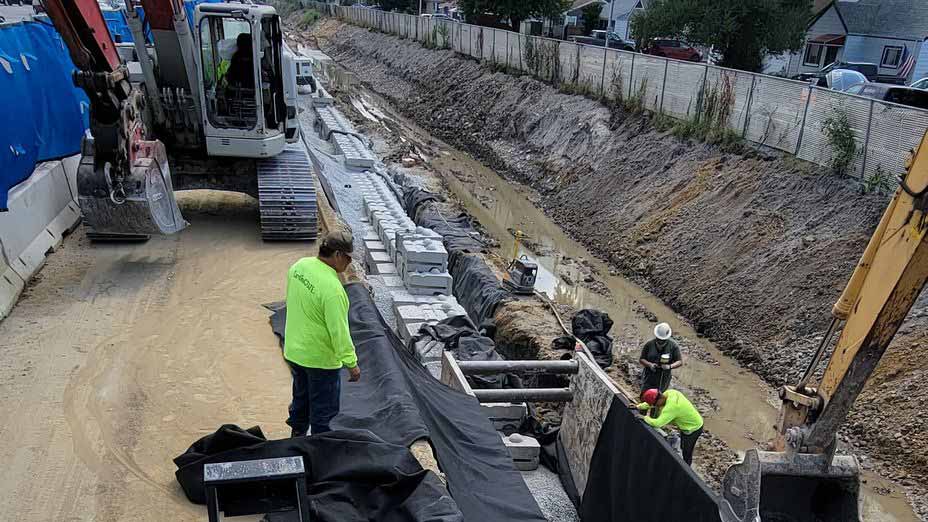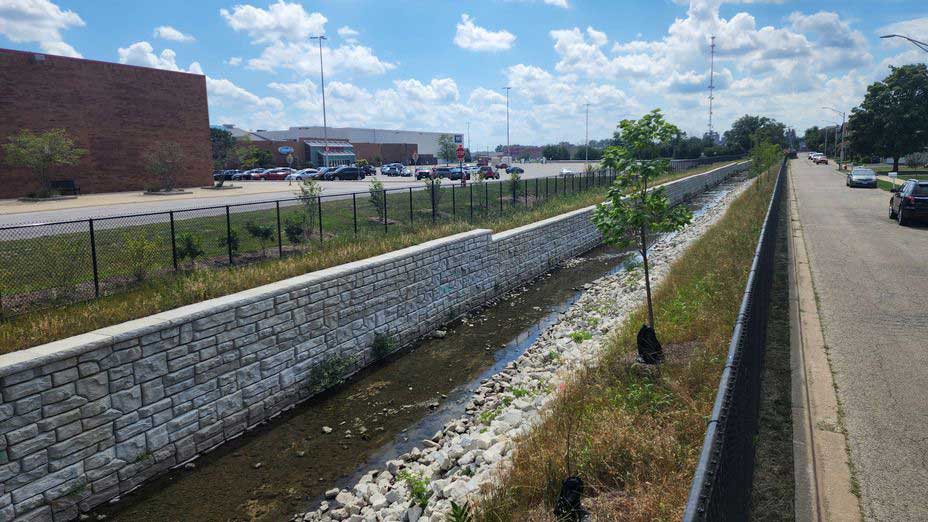Award-Winning Project Guards Against Neighborhood Flooding
Chicago-area stormwater management project showcases Redi-Rock’s installation versatility
THE CHALLENGE
Chicago’s Melvina Ditch Reservoir was constructed in 1965 to mitigate unwanted stormwater runoff for much of the city of Chicago and its southern suburbs. Increased rain events over the ensuing decades ultimately exceeded the capacity of the reservoir in 2013 and 2014, flooding the streets, yards, and basements of several hundred residential properties in nearby neighborhoods.
The Metropolitan Water Reclamation District (MWRD) of Greater Chicago broke ground on the Melvina Ditch Reservoir Expansion project in 2018, slated to double the reservoir’s holding capacity to 117.3 million gallons (444 million liters). The enlargement of the reservoir demanded significant improvements to the connected Melvina Ditch, the key stormwater diversion channel responsible for carrying much of the runoff away from the reservoir and the affected neighborhoods.
The Streambank Stabilization phase of the project focused on protecting adjacent roadways and businesses from active streambank erosion, restoring storm sewer outlets, and reestablishing active vegetation within the riparian corridor. Twin box culverts were to be placed at the north end of the project area and a retaining wall system and riprap was slated for installation along the remaining length of the ditch. The stream banks in this stretch had deteriorated due to erosion and slope failure, threatening eight adjacent commercial and residential structures and accompanying critical infrastructure. The retaining wall would measure approximately 12.5 ft (3.8 m) at its tallest point and stretch 2,600 ft (792.5 m) long.
THE SOLUTION
Cast-in-place walls were not a viable option for the retaining wall for several reasons. “Many penetrations for water mains, storm sewers, and utilities weren’t depicted in the project drawings and considerable finesse was necessary to ensure they were protected and the adjacent walls installed properly,” said Roger Wiese, president of wall design and installation firm Cardinal State LLC. “The versatility and installation ease of Redi-Rock gravity retaining wall blocks helped overcome this challenge.”
Since the Melvina Ditch site is on an active diversion channel, installation crews were faced with constantly saturated subsoils. Redi-Rock blocks are not compromised by water and can be effectively installed in wet conditions. Crews overexcavated and backfilled with additional gravel base and poured concrete aprons in areas to effectively host the Redi-Rock gravity blocks.
 More square footage can be installed in less time using Redi-Rock, helping installation stay close behind excavation to ensure prepared areas were not reclaimed by water.
More square footage can be installed in less time using Redi-Rock, helping installation stay close behind excavation to ensure prepared areas were not reclaimed by water.
Installation had to be quick and remain close behind the excavation crews to ensure excavated and prepped areas were not washed out by the stream. When installation crews reached the section of the ditch adjacent to the Chicago Ridge Mall’s service drive and parking lot, the narrowed project area prevented standard sloped excavation practices. Instead, a 20-ft (6-m) long shoring box was utilized to keep the backslope in place while the wall section was installed. The necessary use of the shoring box meant multiple course sections of the 12-ft (3.65-m) tall wall were installed 20 feet (6 m) at a time rather than the normal practice of setting a base course of up to 0.5 mi (0.8 km) first, then adding single courses while backfilling.
 In addition to preventing erosion of the Melvina Ditch, the Redi-Rock gravity retaining wall also ensures the parking lot and access road to the Chicago Ridge Mall will not fail.
In addition to preventing erosion of the Melvina Ditch, the Redi-Rock gravity retaining wall also ensures the parking lot and access road to the Chicago Ridge Mall will not fail.
THE OUTCOME
The Melvina Ditch Streambank Stabilization project was completed in early December 2021. Aesthetic touches included a Ledgestone texture and solid caps to deliver the finished look. The expansion of the Melvina Ditch Reservoir and the corresponding stabilization of the Melvina Ditch will significantly reduce flood risk for approximately 430 Chicago-area residential properties.
 Ledgestone texture offers a random, stacked appearance that pairs nicely with adjacent riprap installations.
Ledgestone texture offers a random, stacked appearance that pairs nicely with adjacent riprap installations.
As a result, Storm Water Solutions (SWS) recognized the Melvina Ditch Streambank Stabilization Project as one of its ten Top Projects for 2022. SWS is a highly respected industry publication covering “timely news, storm water and erosion control industry trends, technical solutions and best practices.” The SWS Top Projects Awards program highlights the most remarkable and innovative stormwater and erosion control projects of the year.
“The Redi-Rock wall was essential to the success of this important project,” Wiese said. “It supports a 40-acre parking lot and a streambank that diverts tens of millions of gallons during a storm event.”
A highly technical project undertaken on a dynamic site, the Melvina Ditch Streambank Stabilization project execution demanded seamless coordination and a retaining wall system that delivered on all fronts.
PROJECT DETAILS
Project: Melvina Ditch Streambank Stabilization Project Project Design Engineer: Stantec Owner: Metropolitan Water Reclamation District of Greater Chicago Installer: Cardinal State, LLC Manufacturer: Brown Precast Location: Oak Lawn & Chicago Ridge, IL Year Built: 2021
Products Featured in this Case Study
Gravity Retaining Wall Blocks - Massive, one-ton Redi-Rock gravity blocks rely on the sheer mass of each block to hold back the earth.
Cap Blocks - Redi-Rock cap blocks are the perfect way to finish a retaining wall, freestanding wall, or column.
Ledgestone Texture Blocks - Redi-Rock Ledgestone blocks mimic the look of real quarried stone.